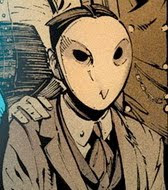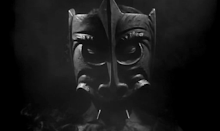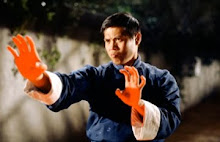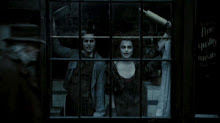
Lets start at the very beginning shall we?
Not just at the beginning of Nolan’s career, but at the presumption that Nolan’s is a career worth examining. Something that plenty of people dispute on its own. There are plenty who write off Nolan as a more graceful then average studio hack.
I of course, disagree or else I wouldn’t be hosting this blogothon. But it is a valid question. Because while he might not wear them as on his sleeve as say a Coppala, the filmmaker I think Nolan most resembles as a stylist, yet blessed free off Coppala’s self destructive streak. Nolan does have a few key obsessions and themes he keeps returning to giving his pictures the unifying thread necessary for some real artistic observation.
1. Nolan heroes are all defined by a trauma. What they do and who they are comes from a fundemental inability to move on with their lives from a defining incidents. Whether its death of Bruce Wayne’s parents, the “murder” of Leonard’s wife, Dormer’s trouble with Internal Affairs, The death of Angier’s wife. Every Nolan protagonist has a defining incident that pushes them past the point of sanity.
2. Nolan villains serve not just antagonists to the heroes, but to society at large. All are defined by the fact that they are breaking the social contract in a way that’s beyond the simple motives of greed, revenge, or whatever serves as fuel for most movie bad guys. Nice people do not use their friends as contract killers/ murder young girls in their home/ burn down major metropolian cities/ kill The police commissioner judges and DAs.
3. There is a complete Co Dependancy between the hero and villain. The entrapped cop and killer become “partners”. The Joker defines himself completely by Batman. Leonard depends on Teddy to help him navigate the world. Teddy depends on Leonard for something much darker. Ras Al Ghul sees in Batman an heir. The rivalry between Danton and Angier define every aspect of both their lives.
4. Nolan’s editing is slow and his eye for compostion nearly unrivaled. His films are made not for quick cuts, but to withstand long hard looks.
5. Each of his movies is Non Linear to at least some extent (Insomnia is almost an exception, but even it uses as its centeral image a flashback whose meaning doesn’t become clear until the end of the film). Most Nolan films take as one of its theme, the mind, and its fragility.
So there are at least five signatures that Nolan places in each film. And true to form, all five are present in Following.
Following isn’t a perfect film, but it is just about a perfect example of a talent in embryo. Every aspect of what makes Nolan Nolan is present, if not matured to its full potential.
The problem with Following is that its simply too clever for its own good. Unlike Nolan’s other films which are exactly clever enough for their own good.
Had it stuck to its initial premise Following might have been a truly great film. Our nameless protagonist starts following random people, out of sheer boredom and loneliness. Inevitably he’s caught in the act, unfortunately he’s done so by the Mephistophelian Cobb (The first of Nolan’s co dependant duos), who far from curtailing his urges, adds fuel to the fire and starts pushing him to take things further then he ever has before.
Now that’s some pretty potent stuff, unfortunately Following was made during that short window where The Usual Suspects was the most influential crime film. Which is the only reason I can think of as to why we’re treated to a tacked on plot involving a gangster and his girlfriend, that positively shreds suspension of disbelief. Hinging on so many coincidences and things happening just so that the mind reels.
Still if Nolan’s instincts as a storyteller where not yet fully developed, his instincts as one of the most confident stylists of his generation are fully formed from the beginning. Nolan’s instincts of compostion are nearly preternatural. I’m all for democratization, but I hate the lazieness of so much mumblecore, where composition and competence are tertiary concerns at best.
Looking at an independent film from a mere ten years ago, shows just how much that label has degraded in the ensuing decade. Call me a scrooge, but I miss the days when to achieve success as a director, an independent filmmaker like Richard Linklater, Jim Jaramusch, Sam Raimi, Peter Jackson, and yes even Kevin Smith, had to make something that actually looked like a film.
Visually speaking comparing something like Following where every shot had to count on its clearly limited budget, It’s barely seventy minutes long, shot on 16mm high contrast To the sloppy infinite video style of today, is like comparing the MLB to a bunch of preschooler’s playing T ball. There’s an economy and a precision here, that speaks to a true artistry. Nolan knew exactly how many frames he had, he couldn’t afford to waste a single one. It’s the discipline like this that a true filmmaker needs. I mean look, it makes the solipsistic wankfests that pass for independent cinema today just look ambitionless and embarrassing. Every shot in Following communicates something, and does so with grace and panache.








Following found Christopher Nolan in full possession of his talents. His next film would find a story worthy of them.





































































































5 comments:
Following introduces Nolan's penchant for unusual structures, and said structure makes the film more interesting and enjoyable, but the format doesn't strike me as essential to the story. In Memento and all his later films, it seems to me that there's a much stronger connection between medium and message. I really like Following, but it feels ever so slightly artificial.
Or so it seems to me.
Oh I completely agree.
Never seen Following, but plan on doing so soon. I like what you mention about the importance of framing a film, not many directors take as much care with this in todays films as they shoot. I think they give more importance to the editing, and the flashy tricks they can use.
I prefer the old school approach of framing a shot perfectly, same way Kubrick used to. I mean, when you see films from superior directors, you can simply tell the difference, between something thats been done with care and true artistry and crap.
Just the other day I say Friedkin's The French Connection and was blown away by the care taken in framing everything so perfectly, so beautifully. It also reminded me of just how beautiful a film looks when its actually shot on film. It adds a different look and texture to the film.
Nolan takes his time framing and planning the sequences. Cant wait for INCEPTION! The curiosity for that one is eating me alive!
I hear you man. I've been running away from every review with my fingers in my ears on that one.
Sorry, Bryce, have to call you on this one too. I find most of your comments insightful, but you don't need to justify Nolan as a great stylist. Having a style, doesn't make one a "stylist" in the idiomatic usage of the word. I compose shots and design story boards on a regular basis. I see nothing in Nolan's compositions to suggest any preternatural ability. I would reserve that for someone like Steven Spielberg, whose compositions somehow build into each other in a more complex manner than any of the Italian cinematographers. To understand complex composition study the works of Gustave Dore who uses triangles within triangles to create his lines of action and centers-of-interest. Stanley Kubrick is the example of someone who uses complex symmetry to create unsettling compositions. It's almost like Japanese art in that most of his shots fixate squarely on its center (normally something that would be boring), but still manage to incorporate more symmetrical patterns like Indian art. You would have to come from an art background to understand this. A place like Art Center still teaches these ideas, but film schools have lost the ability to teach them and rely on intuition as opposed to principle and application. This is my experience having attended both the best film school in the U.S. and the best art school on the West Coast.
Post a Comment